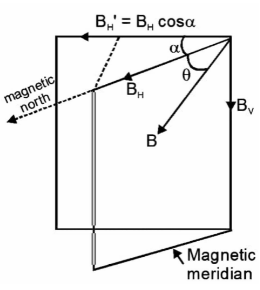
Answer
395.1k+ views
Hint: Let us get some idea about meridian. A (geographic) meridian (or line of longitude) is half of an imaginary great circle on the Earth's surface, a coordinate line terminating at the North Pole and the South Pole, linking points of equal longitude measured in angular degrees east or west of the Prime Meridian.
Complete answer:
Now let us understand about the magnetic meridian. The magnetic meridian is the vertical plane that passes across the magnetic axis of a freely suspended small magnet. The magnetic field of the earth is directed in the direction of the magnetic meridian.
Let us come to this diagram and understand the answer of the problem.

In first case
$\tan \theta = \dfrac{{{B_v}}}{{{B_H}}}........(1)$
In second case
$\tan {\theta ^1} = \dfrac{{{B_v}}}{{{B_H}\cos x}}....(2)$
Form (1) and (2) we get
$\therefore \dfrac{{\tan {\theta ^1}}}{{\tan \theta }} = \dfrac{1}{{\cos x}}$
Hence, the value of $\dfrac{{\tan {\theta ^1}}}{{\tan \theta }}$ is $\dfrac{1}{{\cos x}}$.
Note:So in short we can say that the magnetic axis is a straight line that connects the Earth's magnetic poles. The magnetic meridian is a vertical plane that passes around the magnetic axis, and the magnetic equator is a large circle that is perpendicular to the Earth's magnetic axis.
Complete answer:
Now let us understand about the magnetic meridian. The magnetic meridian is the vertical plane that passes across the magnetic axis of a freely suspended small magnet. The magnetic field of the earth is directed in the direction of the magnetic meridian.
Let us come to this diagram and understand the answer of the problem.

In first case
$\tan \theta = \dfrac{{{B_v}}}{{{B_H}}}........(1)$
In second case
$\tan {\theta ^1} = \dfrac{{{B_v}}}{{{B_H}\cos x}}....(2)$
Form (1) and (2) we get
$\therefore \dfrac{{\tan {\theta ^1}}}{{\tan \theta }} = \dfrac{1}{{\cos x}}$
Hence, the value of $\dfrac{{\tan {\theta ^1}}}{{\tan \theta }}$ is $\dfrac{1}{{\cos x}}$.
Note:So in short we can say that the magnetic axis is a straight line that connects the Earth's magnetic poles. The magnetic meridian is a vertical plane that passes around the magnetic axis, and the magnetic equator is a large circle that is perpendicular to the Earth's magnetic axis.
Recently Updated Pages
10 Examples of Evaporation in Daily Life with Explanations

10 Examples of Diffusion in Everyday Life

1 g of dry green algae absorb 47 times 10 3 moles of class 11 chemistry CBSE

What is the meaning of celestial class 10 social science CBSE

What causes groundwater depletion How can it be re class 10 chemistry CBSE

Under which different types can the following changes class 10 physics CBSE

Trending doubts
Fill the blanks with the suitable prepositions 1 The class 9 english CBSE

Which are the Top 10 Largest Countries of the World?

How do you graph the function fx 4x class 9 maths CBSE

Differentiate between homogeneous and heterogeneous class 12 chemistry CBSE

Difference between Prokaryotic cell and Eukaryotic class 11 biology CBSE

Change the following sentences into negative and interrogative class 10 english CBSE

The Equation xxx + 2 is Satisfied when x is Equal to Class 10 Maths

In the tincture of iodine which is solute and solv class 11 chemistry CBSE

Why is there a time difference of about 5 hours between class 10 social science CBSE




